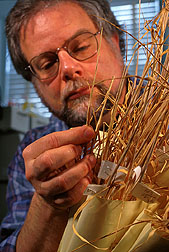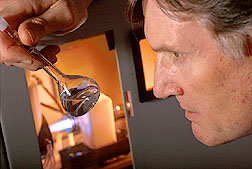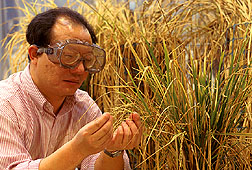Making Harvests More Nutritious
Rather than only increasing yields or improving disease- and insect-resistance in plants, Welch wants to harness the immense power of plant breeding to solve one of the world's biggest malnutrition problems: the shortage of trace elements and vitamins in the diets of billions of people.
"Thanks in large part to the legendary Green Revolution, many more people around the world get enough calories from food for their basic sustenanceexcept in times of famine," says Welch.
"The Green Revolution increased overall production of the high-yielding rice, wheat, and maize that provide large quantities of most macronutrients, notably carbohydrates and proteins.
"Unfortunately," he says, "the huge boost in food production was followed by a global increase in micronutrient malnutrition. These high-yielding foods do not provide enough of the micronutrientsiron, zinc, iodine, essential trace elements, and vitaminsthat are just as critical to health, though needed in much smaller quantities."
During his career as a federal scientist, Welch has worked to transform production agriculture to a system that meets people's micronutrient needs. He and a small group of scientists at the U.S. Plant, Soil, and Nutrition Laboratory at Cornell University in Ithaca, New York, want to bring the tools and knowledge base of plant breeding to bear on the problem of micronutrient malnutrition.
Welch and several colleagues, including Robin D. Graham at the University of Adelaide, South Australia, and Howrath Bouis of the International Food Policy Research Institute in Washington, D.C., are spearheading an international effort to identify varieties of rice, wheat, corn, beans, and cassava that are high in micronutrients.
This research is a collaborative effort with scientists at several Consultative Group on International Agricultural Research (CGIAR) centers, including the International Center for Tropical Agriculture (CIAT) in Colombia, the International Maize and Wheat Improvement Center (CIMMYT) in Mexico, and the International Rice Research Center (IRRI) in the Philippines.
|
|
Their goal: breed plants that more efficiently take up trace metals from the soil and transport more of the micronutrients to edible plant parts, especially the seeds. They also want to propagate plants that synthesize more phytonutrientsthat is, plant-based nutrients and beneficial substances such as beta carotenein their edible parts.
"It's important for plants to accumulate these micronutrients in forms that are biologically available to the human digestive tract for uptake and use," says Welch.
Plants possess genes that regulate how much of these metals is taken up from the soil by roots and deposited at other locations within the plant. These genes first regulate mechanisms that make metals in soil more soluble in soil water. Next, they generate transport molecules that move metals into root cells, from which they enter the plant's vascular system for further transport to other parts of the plant.
"Breeders can selectively produce plant varieties in which these traits are especially prominent," Welch says.
Beans, Beans, a Marvelous Food
Iron deficiency is the most prevalent micronutrient problem in the world, affecting over 2 billion people globally, many of whom depend on beans as their staple food.
Welch is working with a laboratory colleague, ARS animal physiologist William A. House, Cornell University research associate Zhiqiang Cheng, and CIAT scientist Steven E. Beebe in Cali, Colombia. The team selected 24 breeding lines, or genotypes, of common bean seeds from the CIAT bean seed bank. These beans came from diverse genetic backgrounds but shared a common trait—an enhanced ability to accumulate iron and zinc.
The micronutrient-dense CIAT beans selected were grown in a greenhouse in Ithaca in nutrient solution labeled with a radioactive iron isotope, 59Fe. At maturity, radiolabeled bean seeds were harvested, cooked, and freeze-dried. The dried beans were ground up and fed to marginally iron-deficient young rats for 3 hours.
"These beans had been genetically selected for their different iron, zinc, sulfur, tannin, and phytic acid concentrations," says Welch. "Both phytic acid and tannins are known antinutrients that interfere with iron bioavailability in humans. The beans' iron levels ranged from 51 to 157 micrograms per gram of dry weight. Their zinc levels ranged from 30 to 65 micrograms per gram."
Seed color, Welch says, is somewhat correlated to seed tannin levels. White-seeded beans contain low levels of tannin. "To assure variability of seed tannin concentration, we included two white beans in the study," he says.
"Sulfur concentration is an indicator of sulfur-containing amino acids in seeds," Welch adds. "These sulfur-containing amino acids may make it easier for humans to take up and use micronutrients like iron and zinc in foods made from beans.
"Our research showed that by selecting beans with high iron concentrations, we also produced beans with greater quantities of bioavailable iron. The enhanced level of iron was readily taken up and used by the rats' bodies," Welch says.
"Depending on the genotype, isotope-labeled beans contained a wide range of bioavailable iron, phytic acid, and tannin concentrations. However, when we fed the cooked bean meal to rats, we found no relationship between iron, phytate, and tannin concentrations and the amount of bioavailable iron."
According to House, the bioavailable iron varied from 53 to 76 percent of the total iron found in the bean seed.
The international team next plans rat-feeding studies to screen more iron- and zinc-enriched genotypes selected from 1,440 accessions in the Cali bean collection for their iron and zinc bioavailability. "This core collection represents the full range of potential genetic variability among bean species for any given trait," Welch says.
Beyond Beans
In the future, other rat studies are planned with scientists at other CGIAR centers, including CIMMYT and IRRI. These will determine the iron and zinc bioavailability in select micronutrient-enriched lines of rice, wheat, corn, and cassava.
"Our results indicate that plant breeding can be used to enhance micronutrient concentrations in staple plant foods," Welch says.
Breeding staple plant foods for higher iron, zinc, and provitamin A carotenoid concentrations could contribute significantly to improving the micronutrient status of people depending on these foods as major components of their diet.
What Fertilizing Can Also Do
Besides changing the expression of genes in the plants themselves, Welch says farming systems and agronomic practices can be modified to improve the healthfulness of food supplies.
"The nutritional quality of food crops can be greatly affected by the types of fertilizer used and their placement within the soil," he says. "Adequate fertilization can significantly increase levels of vitamins in plant tissue. Well-nourished plants produce more vitamins than those poorly nourished."
But while certain micronutrient fertilizers and fertilizer practices are well suited to increasing the density of micronutrients in plant foods, others are not.
For example, using zinc fertilizers can increase the zinc content of food crops like beans and wheatimproving them as a micronutrient source. However, "For this to happen, the zinc in the fertilizer must be available to the roots for absorption while the plant is making seeds," Welch says.
|
|
Several years ago, he led a research team in a field study on zinc uptake. Their study included peas, snap beans, cabbage, and table beets. They applied zinc sulfate and phosphorus in narrow strips at varying ratesfrom 0 to 80 kilograms per hectare.
The response, they found, depended on the levels of phosphorus and zinc used. Zinc uptake improved with increasing supply when phosphorus was applied at rates needed for optimum yields.
"On the other hand, the study showed that applying phosphorous without zinc decreases zinc concentration in seed," he says. "Only when adequate levels of phosphorus and more than adequate levels of zinc are applied, do seed concentrations of zinc begin to rise."
Placement of fertilizer in the soil is also important. Welch cites research showing that zinc fertilization 2 feet below the soil surface or foliar applications during reproductive growth are much more effective than surface applications at changing the zinc concentrations of cereal grains.
He says that during grain development, the amount of subsoil zinc available is more important than zinc on the soil surface. During plant development, many surface soils become dry, while subsoils remain moist longer, enhancing nutrient uptake.
"Zinc fertilizer is fairly immobile in soils," he says. "Thus, root activity is greater in the moist subsoil during seed filling, while roots in the drier surface soil become less active in acquiring zinc during this phase of plant development."
Welch says that "to meet the enormous challenges imposed by increasing global population pressures, a new greener revolution must build on historic gains. It must emphasize the rediversification of farming systems that include micronutrient-rich cropslike beans, peas, lentils, fruits, and vegetablesas well as cereals. It must address the increasing need for all staple foods without sacrificing essential micronutrients in the bargain."—By Hank Becker, Agricultural Research Service Information Staff.
This research is part of Human Nutrition Requirements, Food Composition, and Intake, an ARS National Program described at http://www.nps.ars.usda.gov/programs/appvs.htm.
Ross M. Welch is at the USDA-ARS U.S. Plant, Soil, and Nutrition Research Laboratory, Tower Road, Ithaca, NY 14853; phone (607) 255-5434, fax (607) 255-1132.
"Making Harvests More Nutritious" was published in the May 1999 issue of Agricultural Research magazine.











